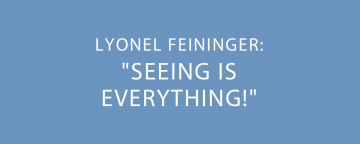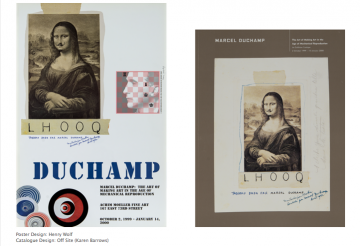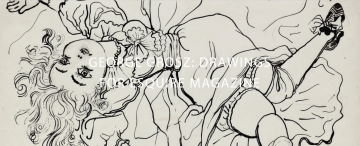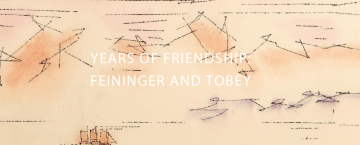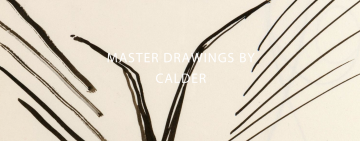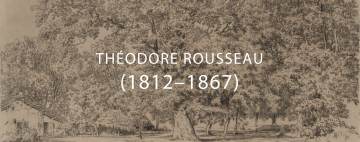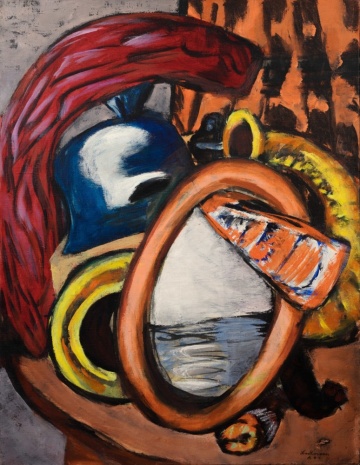Moeller Fine Art
7 East 60th Street (entrance at 1 East 60th Street - The Metropolitan Club)
New York, NY 10022
By Appointment
212 644 2133
New York, NY 10022
By Appointment
212 644 2133
Moeller Fine Art Ltd., founded in 1972, specializes in late 19th and early 20th Century Masters, and is the foremost gallery in the United States for works by German Expressionists and the Masters of the Bauhaus. For more than fifty years, Achim Moeller, the gallery's principal, has helped build important private and public collections that are coherent in concept, period, and quality.
Works Available By:
Alfred Kubin
Karel Appel
Jean (Hans) Arp
Bernard Aubertin
Giacomo Balla
Clive Barker
Ernst Barlach
Max Beckmann
Kate Bellm
Alexander Calder
Marc Chagall
Le Corbusier
Paul Cézanne
Edgar Degas
Otto Dix
Piero Dorazio
Jean Dubuffet
Marcel Duchamp
Max Ernst
Lyonel Feininger
T. Lux Feininger
Lucio Fontana
Sam Francis
Hermann Goepfert
Paul Goesch
George Grosz
Oskar Holweck
Alexej von Jawlensky
Wassily Kandinsky
Ernst Ludwig Kirchner
Paul Klee
Oskar Kokoschka
Willem de Kooning
František Kupka
Yayoi Kusama
Walter Leblanc
Jacques Lipchitz
Heinz Mack
Albert Marquet
Henri Matisse
Joan Miró
Amedeo Modigliani
Laszlo Moholy-Nagy
Henry Moore
Louise Nevelson
Emil Nolde
Victor Obsatz
Max Pechstein
Richard Pettibone
Pablo Picasso
Otto Piene
André Raffray
Odilon Redon
Gunnar Örn
Lucas Samaras
Kurt Seligmann
Georges Seurat
Gino Severini
Jesús Rafael Soto
Mark Tobey
Félix Vallotton

The Metropolitan Club
Andreas Feininger, T. Lux Feininger, Lyonel Feininger
A Family Passion: Photographs by Andreas, T. Lux, and Lyonel Feininger
On the occasion of the exhibition Andreas Feininger. New York in the Forties at the Bröhan-Museum, Berlin, I am pleased to present a viewing room featuring a selection of 18 vintage gelatin silver prints by Lyonel Feininger (1871–1956) and his sons Andreas (1906–1999) and T. Lux (1910–2011).
In 1927, Andreas built a darkroom in the basement of the Feininger family’s master house at the Bauhaus, Dessau. Soon photography became a passion for him, his brothers T. Lux and Laurence (1909–1976), and their father. A year later a proud Lyonel could report to Alfred H. Barr, Jr.: “All three boys are good amateurs with the camera and of course do their own developing and printing, on which so much depends.” Lyonel’s pride was not without merit, since by then both Andreas and T. Lux were represented by the Berlin photo agency DEPHOT, and in 1929 their photographs were shown alongside those of László Moholy-Nagy and Hugo Erfurth at the Film und Foto exhibition of the Deutscher Werkbund in Stuttgart.
T. Lux started photographing in 1925, when he found an old Kodak box camera. A year later, he bought a Voigtländer Bergheil plate camera with which he made his iconic photographs of life at the Bauhaus. “I wanted life, movement, faces, and the human forms,” he wrote in his autobiography. “The Bauhaus architecture which fascinated me provided the stage on which the daily drama of being was performed.” One of his subjects was his father, who he frequently photographed during their extended stays in Deep (now Mrzeżyno) on the Baltic Sea.
Andreas started out as an architect and became seriously involved with photography after he moved to Sweden in 1933. He began publishing books about photography and continued to work as a professional photographer after he immigrated to the United States in?. There he became best known for his city, landscape, and nature photographs, which were frequently published in LIFE, where he was a staff photographer from 1943 to 1962. In the early 1950s, Andreas initiated a series portraying various professionals with the tools of their fields, as in The Photojournalist, 1951, his portrait of the young photojournalist Dennis Stock.
Lyonel started out as a photography skeptic, but by 1928, he had enthusiastically embraced the medium. He enjoyed exploring the interplay between light and shadow, as well as discussing photography with his sons. Like T. Lux, he acquired a Voigtländer Bergheil plate camera and made enlargements in the family’s dark room. He photographed the engine in (Steam Locomotive), c. 1928, in Dessau’s main train station. During exposure he may have used gauze or nails to create the pattern overlaying the image. In 1935, while living in Berlin, he enjoyed photographing people on the street with telephoto lenses. As he wrote to Andreas: “‘The long focal length’ was always the starting point of my painting-perspective and now I see it reinforced in photo-science. Gorgeous!”
Lyonel Feininger
Lyonel Feininger: "Seeing Is Everything!"
On July 17, 1871, Lyonel Feininger was born in New York City. In celebration of this anniversary of his birth, it is my pleasure to present Lyonel Feininger: "Seeing Is Everything!" A Small Retrospective of Drawings and Watercolors, an exhibition showcasing a selection of rare drawings and watercolors by this seminal artist.
The exhibition includes 45 works that Feininger made between 1908 and 1955. Together, they provide a fresh, comprehensive look at the range of his oeuvre by showing the development of his style and motifs, from his formative years in Paris to his success as a master at the Bauhaus to his return to his native New York in 1937.
Max Beckmann, Alexander Calder, Paul Cézanne, Otto Dix, Piero Dorazio, Lyonel Feininger, Sam Francis, George Grosz, Alexej von Jawlensky, Wassily Kandinsky, Ernst Ludwig Kirchner, Paul Klee, František Kupka, Richard Linder, Marisol, Henri Michaux, Jean-François Millet, Lucas Samaras, Mark Tobey, Édouard Vuillard
Master Drawings New York
Théodore Rousseau, Jean-François Millet, Alexej von Jawlensky, Wassily Kandinsky, Max Beckmann, Otto Dix, George McNeil, Édouard Vuillard, Paul Klee, George Grosz, Lyonel Feininger, Alexander Calder, Julio González, Marisol, Lucas Samaras, František Kupka, Ernst Ludwig Kirchner, Richard Lindner, Sam Francis, Mark Tobey, Henri Michaux, Piero Dorazio, Gunnar Örn Gunnarson, Victor Obsatz
ADAA Viewing Room
Lyonel Feininger (1871-1956)
Lyonel Feininger's Woodcuts
Lyonel Feininger frequently numbered his woodcuts at the bottom center. In his numbering system, the first two digits indicate the year he made the woodcut and the last one to two digits serve to keep count of his production in a given year. For example, "184" means that Feininger made the woodcut in 1918 and it was his fourth one made that year, while "1829" means the 29th woodcut made in 1918.
Jean-Étienne LIOTARD, Jean-François MILLET, Théodore ROUSSEAU, Édouard VUILLARD, František KUPKA, Wassily KANDINSKY, Alexej von JAWLENSKY, Lyonel FEININGER, T. Lux FEININGER, Paul KLEE, Ernst Ludwig KIRCHNER, Max BECKMANN, Richard LINDNER, George GROSZ, Otto DIX, Alexander CALDER, Mark TOBEY, Piero DORAZIO, MARISOL, Gunnar ÖRN, Lucas SAMARAS
Crosscurrents: Modern Art
MARCEL DUCHAMP
The Art of Making Art in the Age of Mechanical Reproduction
In 1999, Achim Moeller organized a Marcel Duchamp exhibition at Moeller Fine Art in collaboration with Francis M. Naumann, a renowned Duchamp expert. Titled The Art of Making Art in the Age of Mechanical Reproduction, the exhibition marked the end of the old millenium and ushered in the new. Both the exhibition poster and catalogue, pictured above, are available for purchase.
George Grosz
George Grosz: Drawings for Esquire Magazine
We are pleased to present George Grosz: Drawings for Esquire Magazine, showcasing a selection of fine illustrations by this inimitable German-American artist.
Lyonel Feininger
Lyonel Feininger: An American in Berlin, 1914-1918
A showcase of 19 fine works that Lyonel Feininger (1871–1956) made during World War I. The selection offers insight into the artist’s formal language as it developed during this time.
Feininger, Jawlensky, Kandinsky, Paul Klee
The Blue Four
Lyonel Feininger (1871–1956), Wassily Kandinsky (1866–1944), Alexej von Jawlensky (1864–1941), and Paul Klee (1879–1940) exhibited together as “The Blue Four” between 1925 and 1934. This selection of works is an homage to their association, initiated by artist, dealer, and collector Emilie Esther Scheyer (1889–1945) better known by her nickname Galka (Russian for jackdaw). Scheyer was inspired by what she viewed as the artists’ shared spiritual vision and the transcendent power of their work. She also saw great commercial potential for them and had an idea to introduce them to audiences in the United States, where they were still relatively unknown. Shortly after they formalized their association, Scheyer moved to the United States as their agent and champion. She worked tirelessly to promote their work through exhibitions and lectures, seeking to “[offer] to America…the spirit of the art of painting of Central and Eastern Europe today.”
Lyonel Feininger
Lyonel Feininger in the Harz Mountains
In the two years he spent in the Harz Mountains, Lyonel Feininger further developed his artistic expression, taking inspiration from Cubism. These pencil drawings give an artistically fascinating impression of Feininger's stay in the Harz.
Lyonel Feininger
Lyonel Feininger: Self Portraits and Portraits of Julia
Lyonel Feininger: Self Portraits and Portraits of Julia
Years of Friendship: Feininger and Tobey
Lyonel Feininger (1871-1956) met Mark Tobey (1890-1976) in 1944 at the Willard Gallery in New York, and the two artists kept up a voluminous correspondence (Years of Friendship, 1944-1956, ed. Achim Moeller, Hatje Cantz, 2006) until Feininger's death in 1956. Although Tobey's calligraphic abstractions were worlds away from the ethereal, linear landscapes of Feininger's later years, the two found a conceptual sympathy in their work, which only deepened with their friendship. "His highly sensitive technique captures something of the fleeting values of our life," Feininger wrote for a Portland Museum of Art exhibition catalogue of Tobey's work in 1945, "it is an expression adequate for times like ours, where old-accustomed stability has given way to changed concepts of space, where boundaries are almost nonexistent, and in which the intricacies of existence overlay the fundamentals of life, and man as never before has to struggle for a way out." Tobey returned the compliment in 1954 in an essay for a Feininger exhibition catalogue at the Curt Valentin Gallery, "He does not abstract for abstraction's sake. He draws the essence from the real, reshapes and relates in color, form and line—and gives us his world wherein, if we have the willing mind, and take the time, we are rewarded by becoming more aware, and more sensitive within ourselves."
Alexander Calder
Master Drawings by Calder
A selection of fine drawings by Alexander Calder (1898–1976).
Max Beckmann (1884–1950)
Recent Acquisitions
19th and 20th Century Masters
Recent Acquisitions
Viewing by Appointment
Lyonel Feininger
Thirty Paintings by Lyonel Feininger: A Mini-Retrospective
April 8, 2020 - April 16, 2020
A mini retrospective of thirty extraordinary Lyonel Feininger paintings sold by Moeller Fine Art. Over a deep 50-years engagement with the artist's work, Achim Moeller had the privilege to place them in important private and public collections. An online viewing room is available for your enjoyment.
Lyonel Feininger
The Enchanted World of Lyonel Feininger
November 7, 2019 - February 28, 2020
Exhibition extended for ADAA Gallery Walk this Saturday, February 29, 2020 from 10am to 1pm

Masters through Time
September 6, 2019 - October 18, 2019
Lyonel Feininger at the Bauhaus: Visions of City and Sea 1919–1933
May 6, 2019 - July 26, 2019
Lyonel Feininger
City at the Edge of the World
November 15, 2018 - January 31, 2019

 Back to all Member Galleries
Back to all Member Galleries


